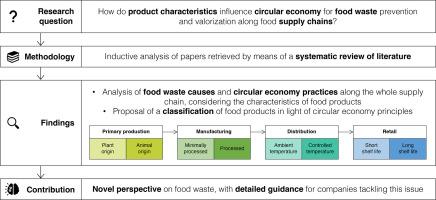A classification of food products to enhance circular economy and reduce waste: A systematic literature review
Abstract
Along food supply chains, one-third of global food production is wasted annually: circular economy can be applied to prevent and recover food waste. The literature has explored food waste from many perspectives; however, no attention has been devoted to understanding how the intrinsic characteristics of food products influence food waste generation and valorization. This study proposes a classification of food products based on circular economy principles derived from a systematic literature review. The classification sheds light on how the intrinsic variability of food products influences food waste generation and recovery along the supply chain. The characteristics that drive differences in terms of food waste are identified by defining two product groups for each step of the chain (primary production: plant origin and animal origin; manufacturing: minimally processed and processed; distribution: ambient temperature and controlled temperature; retail: short shelf life and long shelf life). This stresses the intertwining of food waste with supply chain operations. Moreover, within the same supply chain stage, food waste causes and circular economy actions vary greatly depending on the product characteristics. The review also reveals how the most relevant causes within each product category correspond to a high relevance of practices addressing these causes. The adopted perspective represents a novel contribution to knowledge, providing a clear discussion of the variability of food waste along the supply chain and unveiling aspects requiring further research. From a practical standpoint, the classification can empower food industry actors to develop circular economy actions through an appropriate understanding of product characteristics.


 求助内容:
求助内容: 应助结果提醒方式:
应助结果提醒方式:


